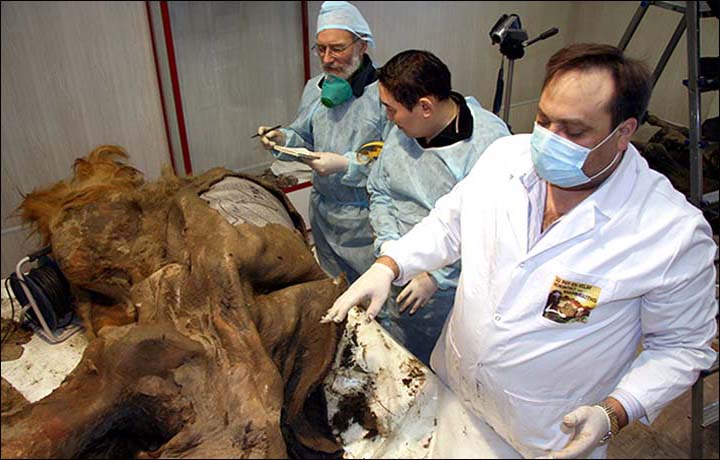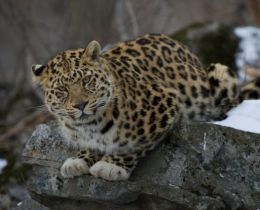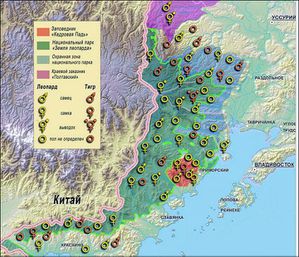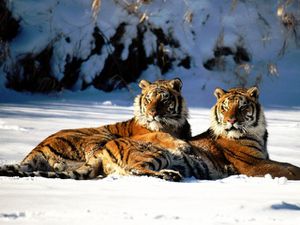Un rapport de 32 pages, à la fois très instructif et très riche de documents photographiques, réalisé sous l'égide de
l'Environmental Intelligence Agency et publié ce jour sur le site de l'Agence, met en lumière la stimulation du trafic tous azimuts de produits issus du tigre par les Chinois DEPUIS DEUX
DECENNIES, en dépit de l'embargo international de 1993 officiellement respecté par ce pays.
http://www.eia-international.org/hidden-in-plain-sight-chinas-clandestine-tiger-trade
Voir aussi, ci-dessous, l'article de Mongabay.com, suivi des deux articles du Bangkok Post de ce jour : un commentaire général et la réponse chinoise.
Voir aussi l'article de ce jour de l'Hindustan Times sur la légalisation par la Chine de la vente de vin de tigre - conçu à partir de poudre d'os -, notamment (mais pas seulement) dans ses 200
"fermes" et celui du China Daily sur la légalisation du commerce des peaux et parties du corps du tigre.
Nous attendons un rapport d'une qualité comparable sur le phénomène aux USA... (voir article blog "Tigres américains : les années
décisives" du 27 janvier).
Chinese government creating secret demand for tiger trade alleges NGO (warning: graphic images)
Jeremy Hance
mongabay.com
February 26, 2013
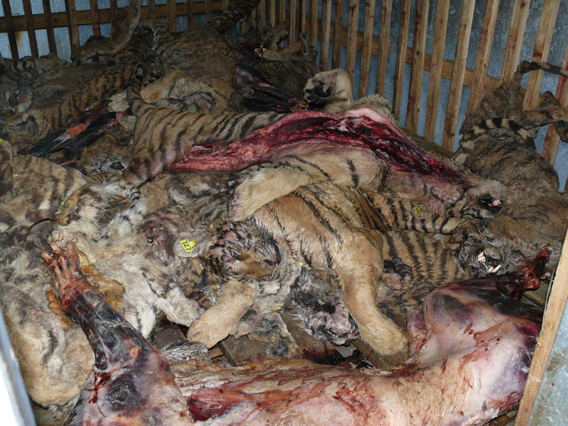
Tiger bodies in freezer in Guilin Tiger Bear Farm. Photo by: Belinda Wright/WPSI.
The number of tigers being captive bred in China for consumption exceed those surviving in the
wild—across 13 countries—by over a third, according to a new report by the Environmental Investigation Agency (EIA). The report, Hidden in Plain Sight, alleges that while the Chinese government has been taking a tough stance on
tiger conservation abroad, at home it has been secretly creating demand for the internationally-banned trade. Few animals in the world have garnered as much conservation attention at the tiger
(Panthera tigirs), including an international summit in 2010 that raised hundreds of millions of dollars for the vanishing wild cats.
"The stark contradiction between China's international posture supporting efforts to save the wild tiger and its inward-facing domestic policies which stimulate demand and ultimately drive the
poaching of wild tigers represents one of the biggest cons ever perpetrated in the history of tiger conservation," says Debbie Banks, head of the EIA's Tiger Campaign.
In 1993, China banned the use of tiger bone, a popular item in traditional Chinese medicine. However, undercover investigations by EIA found that "tiger bones sourced from captive-bred tigers are
not being destroyed, leading to what is likely to be a massive stockpile and consumer assumptions that trade is legal or will soon be legal."
|

Traditional Chinese 'bone strengthening wine.' Note the tiger shaped bottle. Photo by: EIA.
|
However wine made from tiger bones is still being produced and sold in China, and the EIA
says that government has even encouraged it through a "secret" notification issued to traders in 2005. Under the notification any tiger farm housing over 500 tigers could produce and sell tiger
bone wine; in order to circumvent the 1993 law, tiger bone is simply not listed as an ingredient.
"If you get some special permission, you can sell the tiger bones to assigned medicine-making factories and the products will be directly circulated in hospitals," a trader told the EIA.
Traditional medicine is not the only threat to tigers in China. The EIA reports that tiger skins are being sold commercially and in many cases illegally. While the legal tiger skin trade is meant
to be strictly regulated in China, the EIA says the system is "flawed" and provides "a cover for black market activities, including the re-use of permits and falsification of origins," according to
the report. The NGO alleges that China's cat skin trade is fueling consumption not just of captive cats, but the poaching of wild ones as well.
"During just several days, EIA investigators were offered three fresh tiger skins, one leopard skin, one snow leopard skin and big cat bones, teeth and claws," the report reads. In 2011 the
environmental NGO warned nations that China had re-opened trade in wild cats skins.
|
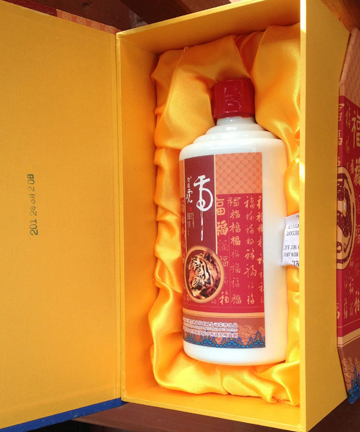
Distributing agent, Beilan, claims in this marketing power point presentation available online, that they supply Sanhong's 'Real Tiger Wine' to high ranking officials and private members
clubs. Photo by: EIA.
|
The EIA argues that China's policies are actively stimulating demand for tiger parts,
undermining global efforts to double tiger populations by 2022. Tigers are currently listed as Endangered by the IUCN Red List; experts say only around 3,500 tigers survive in the wild as opposed
to some 5,000 in China's 200 tiger farms. One hundred thousand tigers were thought to roam the world in 1900, meaning the population has declined a stunning 96.5 percent in just over a century.
While poaching and the tiger trade has helped decimate the big cats, they have also declined due to habitat loss and prey decline.
Banks says China must "vigorously address and terminate this intolerable disconnect between words and deeds which so undermines international efforts to save the tiger."
The EIA calls on China to change its laws to protect tigers, destroy all stockpiles of tiger parts, and let traders know that "the objective is to end all demand and trade."
Banks adds that it's not just foreigners who are calling for these changes, but many Chinese as well.
"A Chinese civil society movement has already appealed for changes to China's wildlife protection laws, and Representatives of the National People's Congress have submitted several proposals in
recently years to amend laws and regulations [...] and to end the commercial utilization of species such as bears and tigers," she notes.
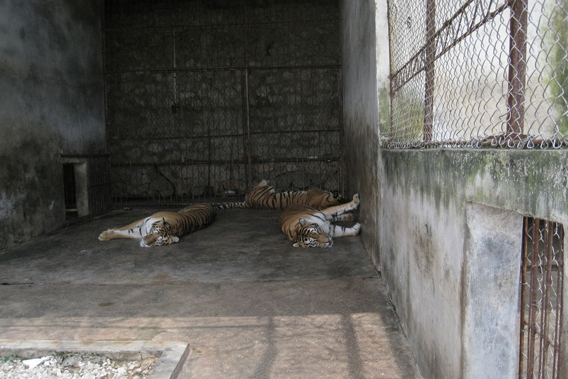
Captive tigers in the Xiongsen Bear Tiger Village. Photo by: EIA.

Tiger skin rug at Xiafeng Taxidermy. Photo by: EIA.
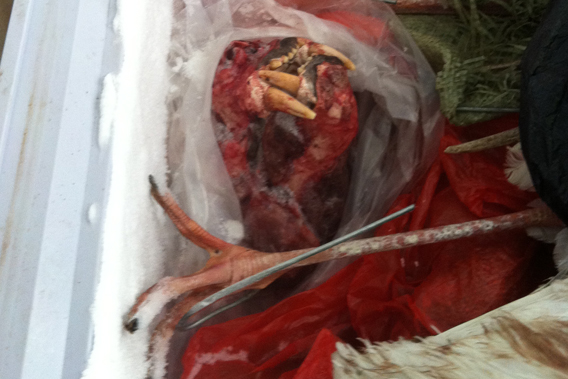
Frozen tiger head at Xiafeng Taxidermy. Photo by: EIA.
Read more at
http://news.mongabay.com/2013/0226-hance-tiger-trade-china.html#AF1KT8C5fiubiPdR.99
Bangkok Post 1. China is allowing the sale of captive-bred tiger skins and body parts despite signing up to a UN agreement which calls for such trade to be banned, a London-based environmental
lobby group claimed on Tuesday.

Siberian tigers in a zoo in Nanjing, east China's Jiangsu province, February 19, 2013. China is allowing the sale of captive-bred tiger skins and body parts despite signing up to a UN agreement
which calls for such trade to be banned, a London-based environmental lobby group has claimed.
The Environmental Investigation Agency (EIA) says that its investigation has uncovered evidence of a legalised domestic trade in captive-bred tiger products -- sold as luxury home decor -- which
it claims stimulates the poaching of wild cats.
The report also presented evidence that suggests traders are using 'secret' government notifications to legitimise the manufacture of 'tonic' wines made using captive-bred tiger bones,
contravening a 1993 Chinese State Council order.
China is signed up to the UN Convention on International Trade in Endangered Species (CITES) which forbids international commercial trade in tiger parts and derivatives.
The accord also calls for domestic trade prohibitions, the consolidation and destruction of stockpiles of tiger parts and products and assurances that tigers are not bred for trade in their parts
and derivatives.
Debbie Banks, Head of EIA's Tiger Campaign, said: "The stark contradiction between China's international posture supporting efforts to save the wild tiger and its inward-facing domestic policies
which stimulate demand and ultimately drive the poaching of wild tigers represents one of the biggest cons ever perpetrated in the history of tiger conservation.
"Pro-tiger trade policies are championed by only a handful of officials in a couple of Government departments and it behoves China to vigorously address and terminate this intolerable disconnect
between words and deeds which so undermines international efforts to save the tiger."
There are around 5,000 captive tigers in China, 1,500 more than in the wild, according to EIA figures.
"The international community should show support for this national movement calling for an end to policies which stimulate demand, and China must make good on its pledges to the international
community and stop cynically stimulating and aiding a trade it has vowed to end," added Banks.
Bangkok Post 2.
China defended its record on protecting endangered species Tuesday after an environmental group accused it of allowing the sale of captive-bred tiger skins and body parts.

Two Siberian tigers (Panthera tigris altaica) at a zoo in Nanjing, east China's Jiangsu province last week. China defended its record on protecting endangered species Tuesday after an
environmental group accused it of allowing the sale of captive-bred tiger skins and body parts.
The London-based NGO The Environmental Investigation Agency said in a report Tuesday that China had a legalised domestic trade in captive-bred tiger products which stimulated the poaching of wild
cats.
In Beijing a foreign ministry spokeswoman insisted China had enacted laws and taken other steps to protect endangered species.
"The Chinese government attaches great importance to the protection of endangered wildlife, including tigers," Hua Chunying told a news conference.
The Ministry of Public Security, which is responsible for law enforcement, was not immediately available to comment on the report.
The EIA presented evidence that suggests traders are using "secret" government notifications to legitimise the manufacture of "tonic" wines made using captive-bred tiger bones, contravening a
1993 Chinese State Council order.
China is a signatory to the UN Convention on International Trade in Endangered Species (CITES) which forbids international commercial trade in tiger parts and derivatives.
The accord also calls for domestic trade prohibitions, the consolidation and destruction of stockpiles of tiger parts and products and assurances that tigers are not bred for trade in their parts
and derivatives.
Debbie Banks, the head of EIA's Tiger Campaign, said: "The stark contradiction between China's international posture supporting efforts to save the wild tiger and its inward-facing domestic
policies which stimulate demand and ultimately drive the poaching of wild tigers represents one of the biggest cons ever perpetrated in the history of tiger conservation.
"Pro-tiger trade policies are championed by only a handful of officials in a couple of government departments and it behooves China to vigorously address and terminate this intolerable disconnect
between words and deeds which so undermines international efforts to save the tiger."
There are around 5,000 captive tigers in China, 1,500 more than in the wild, according to EIA figures.
"The international community should show support for this national movement calling for an end to policies which stimulate demand, and China must make good on its pledges to the international
community and stop cynically stimulating and aiding a trade it has vowed to end," added Banks.
Hindustan Times : vin de tigre. China has officially allowed dose of tiger body parts - traditionally part of Chinese medicines - through an intoxicant - wine.
Selling of Chinese medicines derived from tiger bones has been banned there but not the "tiger tonic wine". The basic wine is made through traditional method but a tinge of tiger bone, before
bottling, has turned out to be its unique selling point. A bottle costs anything between $100 to $800 depending for how tiger bone was in contact with wine.
An investigation by London based non-governmental group, Environment Investigation Agency (EIA) released on Tuesday, has found that tiger bones are soaked in wine and then removed, thereby not
leaving any trace of it in the wine. Therefore, the company selling the wine is not entitled to list the tiger body part as one of the ingredients.
This is the catch.
When it comes to selling, mostly at country's 200 tiger farms, where captive bred tiger are kept for tourists, the tiger link proves to the delicacy.
"A government notification allows use of the bones of the captive-bred tigers to justify the manufacture of 'tonic' wines so no action can be taken against manufacturers," said Debbie Banks, head
of EIA Tiger Campaign.
China, however, insisted that it has enacted laws and taken other steps to protect the wild cat. PTI quoted Chinese foreign ministry spokesperson Hua Chunying to say that the Chinese government
attaches great importance to the protection of endangered wildlife, including tigers.
These tiger farms have around 5,000 tigers - highest population of captive bred tigers in the world - and a stockpile of body parts of many dead big-cats, which are regularly audited by the
authorities. "These bones are kept back in the stockpile at the time of auditing," Banks said.
China's illegal big cat body part industry is considered biggest incentive for poachers, especially in tiger's biggest home in wild, India, to kill the endangered species for a price ranging
between Rs. 10 to Rs. 15 lakh per animal.
Around 60 % of 89 tiger deaths reported from 41 tiger reserves in India in 2012 were poaching related. Many believe that actual poaching could be higher because many a time poachers don't leave
trace of the hunted animal behind for the killing to be reported.
Banks believes that the Chinese government's policy for promoting use of tiger skins as home décor and wine was stimulating poaching of wild tigers and other big cats in South Asia. The civil
society group wants the Chinese government to destroy the stockpile of tiger body parts to effectively check the illegal wildlife trade.
India and United Kingdom has been seeking a ban on tiger farms in China, which the Communist government has refused to accept saying there was no evidence to link tiger farms with increase in
demand for big cat body parts.
China Daily. 26 february. China authorizes the sale of skins and parts of body of tigers raised in captivity in spite of an UN Resolution which it ratified and calling to forbid this type of
trade, declared on Tuesday the Agency of investigation for the environment ( AIE) based in London.
THE AIE asserted having discovered a legal business of products stemming from tigers bred in captivity, intended for the luxury decoration, which, according to her, is going to encourage the
poaching of wild big cats.
The association also noticed that traders use a parallel regulations of the government to legalize "toning" wines elaborated from ossement of tigers bred in captivity, in breach with a decree of
the Chinese Council of State of 1993.
China signed the international Convention on endangered species (CITIES)((ESTATES)) which forbids the international trade of products or its by-products, stemming from tigers.
Et pendant ce temps, un nouveau cas d'électrocution est répertorié en Inde (Hindustan Times, ce
jour).
Yet another tiger was electrocuted and killed in the forests of Katni district during the intervening night of Sunday and Monday. This is the fourth incident of tiger death by electrocution since
November. In all the previous cases, death occurred because of electrocution. Three out of the four cases since November have taken place in Katni district. In all, 14 tigers have died in Madhya
Pradesh since January, 2012. Besides, police in Seoni seized skins of two tigers in September, 2012.
Chief wildlife warden PK Shukla told HT that one person has been arrested in the matter but details would be available only on Tuesday as officials are still camping in the area.
Sources said that on Monday morning, villagers informed the forest department staff that a tiger was lying dead near Machmacha village in Barhi directed and co-produced by Ben Affleck I want to
thank our friends in Iran living in terrible circumstances right now.
I want to thank my wife, who I don’t normally associate with Iran.” forest range of Katni district. Forest department staff reached the spot and found the dead tiger.
The electrocuted tiger was identified as male and its age was about four years.
The spot where the tiger was killed is about 40 kms from Tala - the headquarters of Bandhavgarh tiger reserve.
Sources said that poachers had laid a trap using electrical wires to kill wild animals. However, a tiger seemed to have walked into the trap and got killed. The poachers fled from the spot on
seeing the dead tiger.
All parts of the tiger’s body that can be sold were found intact. A team of veterinarians reached the spot and conducted a post- mortem examination. It confirmed death because of electrocution.



